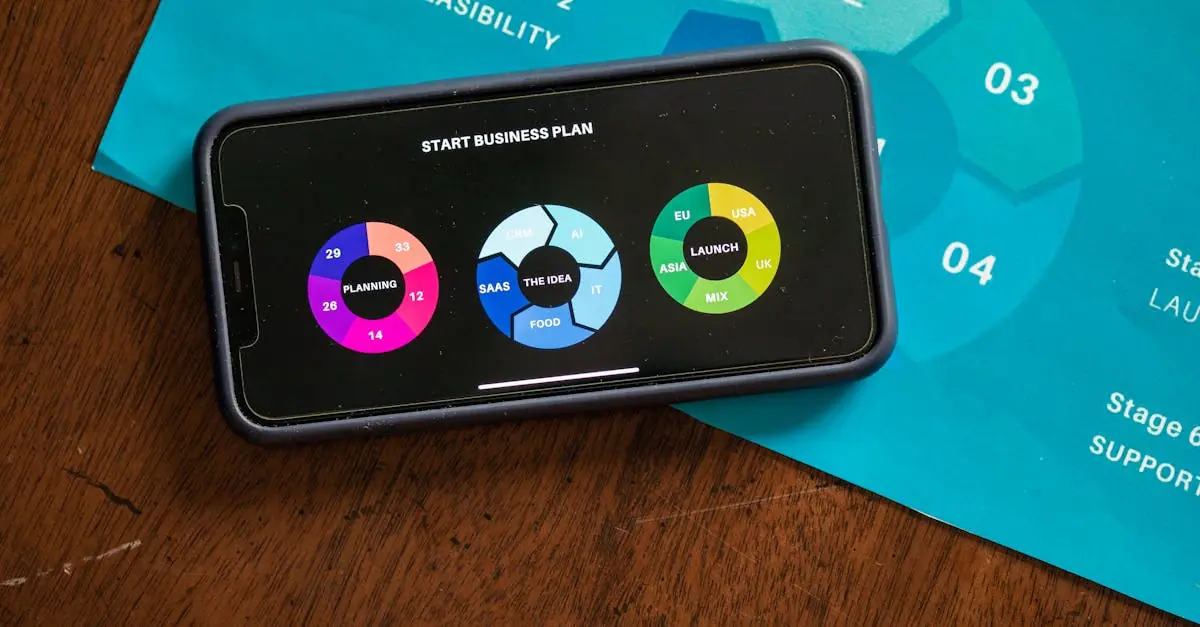In the fast-paced world of software as a service (SaaS), sprint planning is like a well-orchestrated dance—without the right steps, you might just trip over your own code. Picture this: a team huddled around a table, armed with sticky notes and caffeine, ready to tackle the next big project. But wait! Without a solid sprint plan, they could end up sprinting in circles instead of toward success.
SaaS sprint planning isn’t just about setting deadlines; it’s about aligning goals and maximizing productivity. It’s the secret sauce that transforms chaos into clarity, ensuring every team member knows their role in this high-stakes game. So, grab your project management tool and let’s dive into the art and science of sprint planning, where every sprint could lead to a leap in innovation—or at least a few good laughs along the way.
Table of Contents
ToggleOverview of SaaS Sprint Planning
SaaS sprint planning plays a critical role in optimizing workflows and enhancing team productivity. It focuses on defining project goals and determining the tasks necessary to achieve them within a specific timeframe. Teams prioritize features and fix bugs, ensuring every member understands their responsibilities.
During this planning phase, collaboration and communication are vital. Stakeholders discuss project requirements and conflicting priorities. Clear outlines help prevent misunderstandings that could derail progress. Detailed roadmaps support alignment among team members.
Effective sprint planning involves assessing team capacity. Considerations include understanding individual workloads and availability. Teams must analyze past performance to predict future productivity accurately. They use metrics to evaluate how much work can be accomplished in a sprint.
Utilizing agile methodologies facilitates quick adjustments. Teams can pivot in response to changing requirements, which is vital in the fast-paced SaaS environment. Regular reviews promote transparency and continuous improvement.
Tools designed for project management streamline this process. Popular SaaS solutions include Jira, Trello, and Asana. These platforms offer features that assist in tracking progress and managing tasks efficiently. Integration with communication tools enhances monitoring and collaboration.
Emphasizing a culture of feedback during sprint planning strengthens team engagement. Team members feel valued when they contribute ideas. Active discussions lead to innovative solutions that might not surface in a more rigid environment.
To summarize, effective SaaS sprint planning is essential for aligning goals and maximizing productivity. Regular practices ensure clarity, encourage collaboration, and optimize project delivery within the scalable SaaS framework.
Importance of SaaS Sprint Planning
SaaS sprint planning plays a crucial role in ensuring project success. This process involves multiple facets that contribute to the overall effectiveness of a team.
Benefits of Effective Sprint Planning
Effective sprint planning increases team alignment and focus. Teams clarify objectives and prioritize tasks, which boosts overall productivity. It also facilitates better resource allocation, ensuring that developers work on high-impact features first. Regularly reviewing past performance helps teams identify bottlenecks and adapt strategies accordingly. Prioritized features directly impact user satisfaction, leading to non-stop improvements in product quality. Additionally, stakeholder engagement enhances communication, fostering a collaborative environment throughout the project lifecycle.
Challenges in Sprint Planning
Challenges in sprint planning can hinder project momentum. Unclear objectives often lead to misalignment among team members. It becomes difficult to estimate workloads accurately, resulting in potential resource overcommitments. Managing team capacity requires continual assessment, which is often overlooked. Frequent changes in requirements complicate adherence to timelines, creating additional stress. Moreover, integrating disparate project management tools can disrupt workflow, hindering overall efficiency. Recognizing these challenges allows teams to adapt their processes and improve future sprint planning efforts.
Key Components of SaaS Sprint Planning
SaaS sprint planning hinges on key components that drive efficiency and clarity within teams. Understanding these elements helps align objectives and optimize resource allocation.
Defining Objectives and Goals
Establishing clear objectives and goals is crucial during sprint planning. This process starts with identifying the project’s overall vision. Teams should break down this vision into actionable goals, ensuring each objective is specific, measurable, achievable, relevant, and time-bound. Effective goal setting fosters alignment among team members. Prioritization based on customer feedback and market demands allows teams to focus on delivering features that add value. Regularly revisiting and adjusting these objectives enables teams to adapt to changing requirements quickly. Engaging stakeholders in goal definition promotes a better understanding of expectations and enhances collaboration.
Estimating Effort and Resources
Estimating effort and resources accurately ensures successful sprint execution. Teams should evaluate historical performance data to make informed estimates. Breaking down tasks into smaller, manageable units simplifies the estimation process. Collaborative discussions during planning meetings help gather varied insights on effort estimations. Utilizing techniques like story points or ideal hours enhances accuracy. Once estimates are in place, resource allocation becomes clearer, aligning talent with tasks based on skills and availability. Continuous monitoring of progress against estimates allows teams to make adjustments as needed, maintaining momentum throughout the sprint.
Tools and Techniques for SaaS Sprint Planning
Effective tools and techniques enhance SaaS sprint planning efficiency and clarity.
Popular SaaS Tools for Sprint Planning
Jira stands out as a leading project management tool, enabling teams to manage tasks and track progress effectively. Trello offers a visual approach that helps with task organization through cards and boards. Asana allows teams to create detailed project timelines, ensuring that deadlines are met consistently. ClickUp provides flexibility through customized workflows, accommodating various team needs. These tools streamline communication, promote collaboration, and enhance transparency throughout the sprint process.
Agile Methodologies in SaaS
Agile methodologies play a crucial role in SaaS environments. Scrum facilitates iterative progress through short sprints, allowing teams to adapt quickly to changing requirements. Kanban emphasizes continuous delivery while visualizing the workflow, promoting efficiency. Lean focuses on maximizing value by minimizing waste, ensuring resources are utilized effectively. These approaches encourage responsiveness, enabling teams to prioritize essential features and respond to user feedback swiftly. Adapting agile at all stages of development fosters a culture of innovation and teamwork.
Best Practices for Successful SaaS Sprint Planning
Achieving success in SaaS sprint planning requires following specific best practices. Engage the entire team in defining project objectives early on. Clear goals guide efforts, ensuring everyone knows what they aim to accomplish.
Prioritize tasks effectively to maximize team impact. Identify critical features and address urgent bugs. Use historical data to assess task importance and sequence work accordingly.
Utilize project management tools to enhance transparency. Jira and Trello provide platforms for tracking progress and facilitating communication. Explore Asana and ClickUp for collaborative task management.
Collaborate with stakeholders to gather diverse insights. Their feedback ensures alignment with user expectations and business objectives. Invite team members to share thoughts during planning sessions to foster collective ownership.
Monitor progress continuously against established estimates. Adjust strategies based on performance data and team feedback. Agile methodologies promote flexibility, allowing for swift adaptations in response to changing requirements.
Incorporate retrospective discussions into the planning process. Review successes and challenges from past sprints to identify improvement areas. Learning from previous experiences informs better planning for future sprints.
Use estimation techniques like story points or ideal hours for precision. These methods enable teams to gauge workload accurately and set realistic expectations. Encourage open discussions around estimates to refine collective understanding.
Promote a culture of feedback during and after sprints. Encouraging dialogue strengthens team engagement and motivates innovative solutions. Continuous improvement thrives in an environment where constructive input is valued.
Conclusion
SaaS sprint planning is a vital component that directly influences team effectiveness and project success. By establishing clear objectives and fostering collaboration among team members and stakeholders, organizations can navigate the complexities of software development with greater ease.
Utilizing project management tools and engaging in continuous feedback loops ensures that teams remain aligned and adaptable to changing requirements. The emphasis on accurate estimations and prioritization not only enhances productivity but also leads to improved user satisfaction.
Ultimately, a well-executed sprint planning process equips teams to deliver value consistently while maintaining the agility necessary in the fast-paced SaaS landscape.





